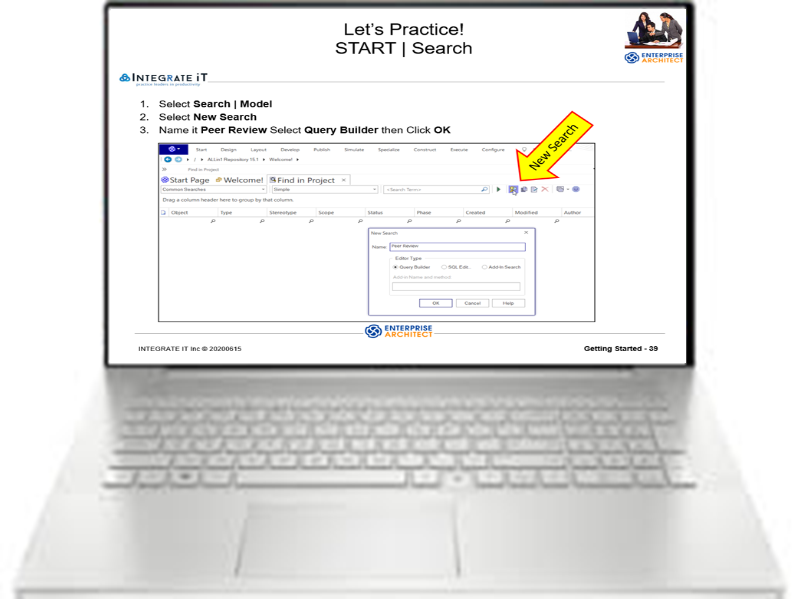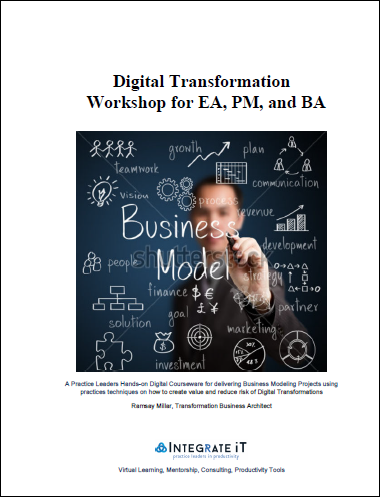Digital Transformation Workshop for EA, PM, and BA
Duration: 3 days Virtual Learning and mentorship led by Practice Leader and Sparx SME
Leaders steering digital business transformation initiatives, in public and private enterprise, need skilled Enterprise Architects, Project Managers, and Strategic Business Analysts to ensure their vision aligns across key stakeholders and many landscapes to ensure the business case is delivered.
Delivering large scale, collaborative, and repeatable transformations with diverse stakeholders is not the experience of most Enterprise Architects, Project Managers, and Business Analysts. Learn insights on how different professional roles are collaborating to improve business value and reduce risk. Gain insights on how leading organizations use common sense and systems thinking to succeed the first time and avoid traditional transformation project failure. Transformation failures continue to increase while leading organizations are succeeding. Why? Find out why and how to succeed by looking over the shoulders of a business architecture practitioner with many years of experience in the trenches assisting his clients in process improvement and transformation success outcomes.
Learn directly from recent case studies on how to succeed when planning and executing a digital transformation. Learn insights to accelerate transformations, improve business flexibility, and reduce the severe risks of transformation failures. Learn how effective Enterprise Architects, Project Managers, Business Analysts working together ensure business agility. We invite you to join Ramsay Millar, a globally recognized Business Architect with years of experience who uses revealed methods and techniques.
What You'll Learn
Experience insights and techniques with Ramsay Millar, who was directly involved in many successful and well documented transformations over the years covered in this workshop. Learn and practice effective business architecture techniques that align with leadership, people, and technology outcomes.
- Digital Transformation Critical Success Factors
- Perform Preliminary Activities
- Model Business Strategy and Vision
- Determine Key Performance Indicators
- Perform Business Analysis
- Architect Business Solution
- Plan and establish initiatives
- Deploy Solution
- Perform implementation governance
- Rolling out a Business Architecture practice Master how to use the Business Architecture Guild BIZBOK© Frameworks.
- Leverage your next project using the supplied INTEGRATED Toolkit and Stencils
- Perform a workshop using a real transformation case study
Certifications
Our expert instructors work closely with every student to personally ensure they fully grasp every lesson plan during the hands-on workshops sessions to ensure that the Certification is achieved.
- Certificate of Education Credit hours is available
Who Needs to Attend
- Business Leaders, Business Analysts, Business Architects, Enterprise Architects, and Project Managers
Course Outline
Digital Transformation Critical Success Factors- Business modeling challenges?
- What does success look like?
- Alignment of strategy with operations
- Business Transformation lessons learned
- Benefits of a business architecture practice
- Leveraging frameworks, patterns and standards
Perform Preliminary Activities
- Begin with the end in mind
- Change Management Leadership
- Initial transformation scoping
- Confirm governance and support frameworks
- Establish business architecture team
- Communication Skills
- Confirm business architecture principles
- Select and tailor business architecture frameworks
- Select reference models
- Select catalogs, matrices, viewpoints and documents
- Implement business architecture tool
- What is a good tool?
- Finalize standards and Tool training
- Request for Business Architecture Work
- Tailored business architecture repository
Model Business Strategy and Vision
- Architecture Vision
- Establish the Architecture project
- Identify stakeholders, concerns, goals, and needs!
- Confirm goals and objectives
- Define Capabilities
- Assess readiness for Transformation
- Scope the organizations impacted
- Confirm Principles
- Develop the Business Scenario!
- Develop the Architecture Vision
- Define the target architecture business case
- Identify the Transformation Risks and mitigation
- Establish the Transformation Communication plan
- Generate the Architecture Vision document
Determine Key Performance Indicators
- Business scenario analysis
- Identify target objectives & outcomes measurement
- Perform impact analysis
- Assessment Techniques
- Capability
- Value Stream
- Process Scope
- Products and Services
- Perform initial business architecture impact analysis
Perform Business Analysis
- Business modeling best practices
- Breaking down complexity
- Develop baseline Business Architecture Definition
- Problem description
- Vision and Scope
- Capability model assessment
- Process value stream assessment
- Process structure assessment
- Applying Business Patterns
- Service assessment
- Product assessment
- Information model assessment
- Needs assessment
- Conduct formal stakeholder review
- Finalize the baseline Business Architecture Definition
Define the Target Business Architecture
- Vision and Scope
- Capability model
- Process value stream
- Scoped Business processes
- Services
- Products
- Information model
- Needs
- Perform gap analysis
- Business Architecture
- Application Architecture
- Data Architecture
- Technology Architecture
- Review and consolidate gap analysis results
- Define target Business Architecture roadmap components
- Conduct formal stakeholder review
- Finalize the target Business Architecture Definition
Plan and establish initiatives
- Finalize opportunities and solutions/li>
- Determine business constraints for implementation/li>
- Define initiatives/li>
- Map objectives to initiatives
- Create initiative metrics
- Determine constraints for implementation
- Initiative tradeoffs & decisions
- Review and consolidate gap analysis results
- Review IT requirements from a functional perspective
- Reconcile interoperability requirements
- Refine and validate dependencies
- Confirm readiness and risk for business transformation
- Formulate high-level implementation and migration strategy
- Identify and group major work packages
- Identify Transition Architectures
- Create portfolio and project charters
Deploy Solutions
- Migration planning considerations
- Confirm management frameworks
- Confirm transition architecture increments/phases
- Generate the architecture implementation roadmap
- Prioritize the migration projects
- Estimate resource requirements and timing
- Engage deployment team
- Create portfolio and project charters
Perform implementation governance
- Implementation governance
- Confirm scope and priorities for deployment
- Identify deployment resources and skills
- Guide development of solutions deployment
- Perform enterprise architecture compliance reviews
- Audit business and IT operations
- Perform pre & post-implementation reviews
Rolling out a Business Architecture practice
- Common approaches for getting started
- Determine business objectives
- Communicate business value
- Assess opportunities to leverage business architecture
- Establish business architecture governance
- Establish business architecture baseline
- Leverage business architecture during initiative planning
- Expand business architecture
- Business architecture Center or Excellence (CoE)
Testimonials
Healthcare Transformation Case Study
“The techniques, templates, case study coverage based upon documented transformation projects provided by during the course saved our transformation team at our Fortune 10 Healthcare company many months of setup time to establish our business architecture Center of Excellence, standards work, and setup time, we began our critical project immediately after training. There isn’t a week that goes by when I’m not using one of the productivity tools to help solve problems, speed things or make my team more productive.” - Fiona Lindberg, CBAP – McKesson Health Systems
Experience the most comprehensive Virtual Learning and Mentorship available for learners interested in growing your career. Learn from an experienced consultant and mentor who reveals proven industry best practices and prepares you or your team to become skilled and confident in your use of Enterprise Architect by Sparx Systems.

Practice Leader, Mentor, Enterprise Architect SME Ramsay Millar has delivered over 1,100 business and technology modeling project assignments and trained over 4,000 business architects, business analysts, enterprise architects, agile project managers, solution architects and software engineers since 2001.
The professionals Ramsay has mentored appreciate his common sense, wide industry skills, and the direct experience he brings to the show.
LinkedIn »

Use your Web Browser to read, learn, search, make notes, and print your personal Practice Leaders eBook. Your supplied eBook contains practical steps required to master and grow confident when using Enterprise Architect to deliver your next project and is directly linked to the ALLin1 EA Repository Case Study.

Download the supplied ALLin1 EA Repository to your PC Desktop. The Repository and additional course resources contain everything you need to get started including a production ready reuseable Repository loaded with Project ad Document Templates, Diagram Stencils, and real-world consulting Case Study samples.



